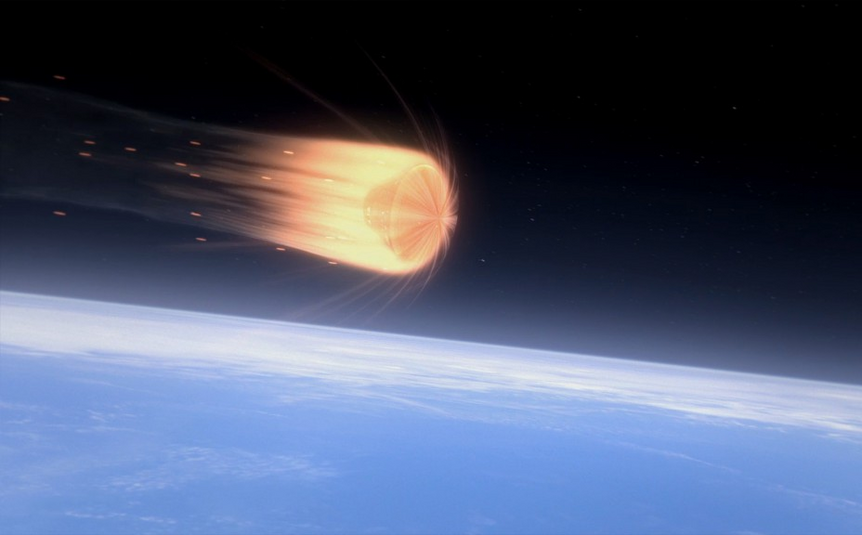Create a free profile to get unlimited access to exclusive videos, sweepstakes, and more!
Watch this Space Probe Experience Fiery Reentry in High-Definition Video
This is what it feels like to come home.
The crew of SYFY’s The Ark is on a one-way journey to Proxima centauri b, an exoplanet 4.2 light-years from here, and the future home of humanity. If they get there alive, they’ll get the rare experience of entering a planetary atmosphere from space, figuratively breathing that most rarified air, superheated to 5,000 degrees Fahrenheit as their spacecraft punches through. It’s the sort of thing that has only been experienced by a few hundred human beings and a growing number of uncrewed satellites and other spacecraft.
Now everyone can experience the thrill of reentry thanks to a high-definition camera mounted to Varda Space’s W-1 space capsule. Varda is an aerospace company hoping to tap the unique microgravity environment of low-Earth orbit to manufacture medicines and other products in space. W-1 is the company’s first in-space test mission. It launched in June 2023 and spent eight months in orbit harboring space-grown crystals of an antiretroviral medication called Ritonavir.
The crystals were finished growing after about a week, but it took a while to coordinate reentry and get the capsule down safely. On February 21, 2024, W-1 scorched a path through the atmosphere and parachuted to the ground at the Utah Test and Training Range in Utah’s West Desert. A week after landing, Varda posted a video to its YouTube page showing the reentry process from the point of view of the capsule itself.
For More on Spaceships:
NASA Just Got a Shipment of Plutonium for Next Class of Nuclear-Powered Spaceships
International Space Station Destined for Point Nemo, the World's Spaceship Graveyard
The Life and Eventual Death of Voyager 1 and 2
Put Yourself Inside a Space Capsule Entering the Atmosphere
The video begins with capsule separation. Still in orbit, you can see the interior edges of the capsule against the nearly empty blackness of space. A sliver of the night-side Earth glows faintly in the dark, a glint of dark blue sky just visible at the edges. The capsule topples slowly end over end, inching ever closer to the atmosphere and the ground below. Flashes of almost blinding light wash over the screen and disappear just as quickly as the capsule angles toward the Sun and away again.
The Earth grows larger as the planet’s dayside emerges through W-1’s tiny porthole window. The Earth begins to dominate the view, though W-1 is obviously still in space. Then the toppling stops and the window points itself toward outer space as light washes out the stars, first white, then orange and red. Hints of yellow emerge first as a haze, then as bursts of color, flaming hot sparks falling away at 25 times the speed of sound.
A river of sparks suddenly stops, the capsule reaching a tenuous equilibrium with the thickening air around it. Still, the curvature of the Earth is clearly visible and the darkness of space beyond. W-1 is falling, falling, and its view through the sky is such that the sunlight scatters, washing out the planet’s surface details in a smear of white. A moment later, the view clears like a curtain of light being pulled open and W-1 is home. It’s still falling, still high above the cloud tops, but something intangible has changed; it has crossed some boundary of perspective and walked through Earth’s front door.
The capsule plunges into a dense layer of clouds and gets lost in a high-flying fog, the final boundary between it and the ground. The blank slate of clouds is punctuated briefly by the Sun, then by a parachute. What began in orbit ends in a thud and a pair of shoes casually walking through the muck, an envoy from W-1’s welcoming committee.
We’ve been launching satellites and other spacecraft since Sputnik opened the orbital door in 1957 and reentry, controlled or otherwise, is an ordinary part of that process. With a few exceptions, on long enough timescales what goes up must come down. And yet, there’s something about seeing the capsule’s return from space that lets you see the world in a new light, even if only for a minute. It’s the way an alien visitor might see our world, full of promise, hope, and wonder. If our descendants greet Proxima centauri (or any other world) with that kind of enthusiasm that’ll be a good thing. If we can figure out how to greet our own world that way, that’ll be even better.
Catch up with the crew of the Ark One when The Ark returns for Season 2, on SYFY!



































